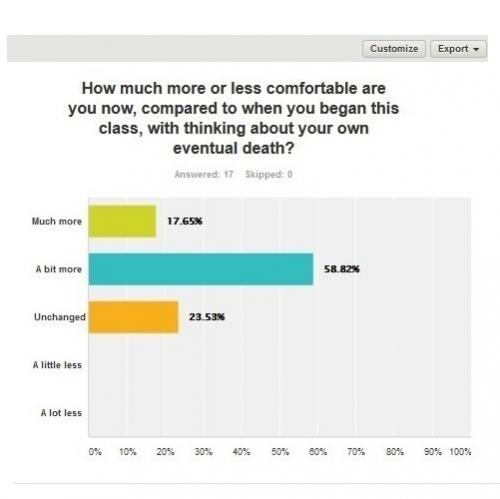
Image Credit:
Lindsey Gay
As the semester winds down, I have been thinking about my students’ responses to my course topic. Death and dying are universal facts, but our various responses to them are far from universal. This week I asked them to complete a short, anonymous survey that summarized their individual responses to the different topics we covered and conversations we had.
This semester marks the third time I’ve taught RHE 309K: Rhetoric of Death and Dying (Summer ‘13, Fall ‘13, Spring ‘14), and it’s gone a bit differently each time. As the semester winds down, I have been thinking about my students’ responses to my course topic. Death and dying are universal facts, but our various responses to them are far from universal. As part of my students’ Learning Records, I asked them to reflect on their own perspectives on death and dying, and to chart how their perspectives or feelings change as the class progresses. “Perspectives” was in fact one of our central course strands, along with Analysis, Research, and Writing. From the very beginning, I assured my students that my goal with Perspectives was not to change their belief systems or their values, but to get them accustomed to determining where their own perspectives originate, how they are formed and influenced, what is valuable about them and why, and what influences their perspectives have in their own lives. This week I asked them to complete a short, anonymous survey that summarized their individual responses to the different topics we covered and conversations we had.
In their Learning Records, my students have often offered profound insights into their own ways of considering death and dying. They report that though they perhaps gave the subjects little or no thought prior to enrolling in this course, they have since found that death and dying are quite interesting topics. Some students realize that their views, whether liberal or traditional, were certainly not the only valuable ways of approaching these topics. Some students have been introduced to death and dying at young ages, having had siblings or parents pass away; in these cases, I have found that the individual may be either much more reluctant to enter class discussions, or much more apt to do so with the confidence that comes from personal experience.
In fact, my students this year have offered so many different perspectives on death and dying that I’ve found it hard to collate them. For my own course development skills, I wanted some way of generalizing their reactions. Were there any specific aspects of the course materials or topics that they agreed on? Did we as a group sufficiently address our Perspectives course strand--that is, did we respectfully, critically, and analytically engage our own experiences, feelings, biases, and beliefs? Admittedly, this idea came to me pretty quickly as I was looking over the day’s lesson plan, so I had to devise the survey only hour before class began. Depending on the results, I may reconsider the utility or worth of some questions.
The results (zoom in!) were interesting. Though I expected the students’ responses to the first seven questions (based on discussions during class and in their Learning Records), I found their responses to #8 unexpected. Some of our most spirited classroom discussions were about legislative or unusual issues, but those received low interest ratings. I wonder whether my ranking system (where 4 = highest interest) ended up being confusing. The responses to #9, where I asked students to tell me what they wish we’d discussed, were incredibly varied: subjects ranged from suicide, to death rituals in other cultures, to Halloween.
Overall, I’m pretty happy with the results. I wanted to engage the students in a slightly different medium, which an online survey accomplishes. Mostly I just wanted a way of gauging their responses that was geared directly toward the course material, as opposed to the depersonalized Course Instructor Surveys they fill out at the end of each semester. I have also been fairly confident of the rhetoric-specific material I’ve presented in class, so I left that out of the survey. I thus confined the survey to purely topical issues of death and dying, rather than issues of rhetorical skill and practice.

